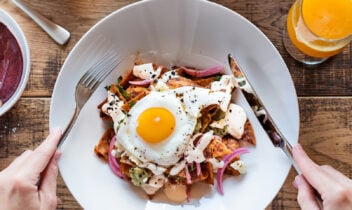October Gardening Tips

Visit often to keep up-to-date. [Get Reminder]

Harvest
Beans, Broccoli and Cauliflower planted in May/June
(NE, upper parts of SE, EC, UC)
Harvesting Tips
Beans
The three most common types of beans planted in a home garden are green, yellow (or wax), and lima beans.
Green Beans
Harvest beans when they are 3-5 inches in length and are a light grass to dark green (color will vary depending on the variety planted). With one hand, hold the bean plant right above a bean that is ready to be harvested and with the other hand gently pull or ‘pick’ the bean from the plant. It’s okay if a little bit of the stem remains attached to the bean.
Video: Using Green Beans
Yellow (Wax) Beans
Harvest beans when they are 3-5 inches in length and are yellow/green to sunshine yellow (color will vary depending on the variety planted). With one hand, hold the bean plant right above a bean that is ready to be harvested and with the other hand gently pull or ‘pick’ the bean from the plant. It’s okay if a little bit of the stem remains attached to the bean.
Lima Beans
The beans grow inside of pods, similar to peas. Harvest when the pod is 3-4 inches in length and 1-1 1/2” wide. Place the pod between your thumb and forefinger and gently apply pressure until the pod ‘pops’ open. Remove the beans and discard the pod. Approximately 2-4 beans will be in each pod. The color of the pod will be a light grass green.Broccoli
Harvest broccoli when the head is 7-12 inches in diameter, firm or hard to the touch, and the flowerets are varying shades of green/gray. Gently grip the sides of the head with your fingers and using a kitchen pairing knife, cut the stem, leaving 4-6 inches attached to the head of the broccoli. You will likely get 1-2 additional cuttings from the same plant before it dies. If you see small yellow flowers on the plant or anywhere on the head of the broccoli, it’s over-ripe and should be placed on the compost pile, thrown away or left in the yard for animal friends to eat. It’s best to harvest broccoli as needed. Video: Selecting Broccoli
Cauliflower
Harvest cauliflower when the head is 7-12 inches in diameter, firm or hard to the touch, and the flowerets are white or light cream. Gently grip the sides of the head with your fingers, and using a kitchen pairing knife, cut the stem, leaving no more than two (2) inches attached to the head of the cauliflower. You will likely get 1-2 additional cuttings from the same plant before it dies. It’s best to harvest cauliflower as needed. Video: How to Cut Cauliflower
Potatoes
This is a fun activity to do with your children. Dig a trench, 18″-24″ deep and 4′-5′ long. You can purchase cut potatoes from your local home and garden center or favorite seed catalog, or you can cut potatoes purchased from your local supermarket or farmers market. Cut 1/4″ – 1/3″ from the tip of the potato, ensuring at least a handful of eyes are present on the cut portion. Place the cut portion in the trench, water, and cover with soil. Over the winter months, the potato will grow into a full-size potato, ready for harvest in March/April of the following year.
Turn the Soil
Fertilize
This step is not completely necessary, but a good one if you are able to complete. Any organic or chemical fertilizer will work, although I have experienced the best results with compost, animal manure (your local farmer will be happy to give you some, likely for free), or mushroom soil. Fertilizing the soil will help to build-up a reserve of nutrients needed for the long winter.

In early-mid November, it’ll be time to prepare the soil for cooler temperatures and the arrival of winter. We’ll provide steps that will help to ensure the soil remains healthy over the winter and is ready to be worked again in the spring. [Get Reminder]
 Step 3: Planting
Step 3: Planting


